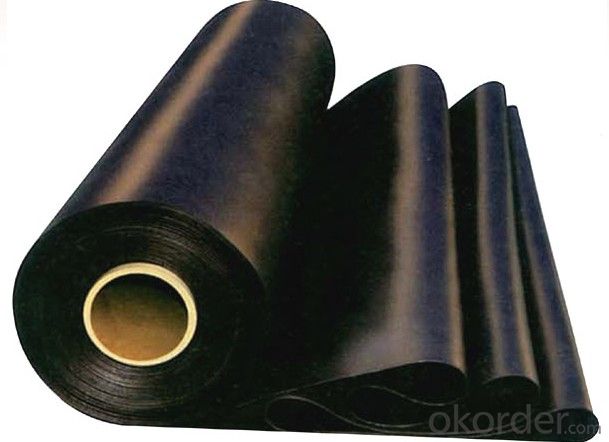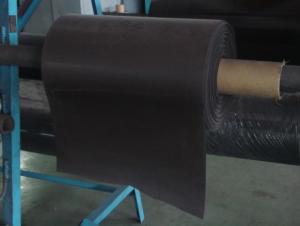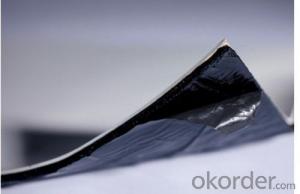EPDM Waterproofing Membrane for Underlayment Protection
- Loading Port:
- China main port
- Payment Terms:
- TT OR LC
- Min Order Qty:
- 5000 m²
- Supply Capability:
- 100000 m²/month
OKorder Service Pledge
OKorder Financial Service
You Might Also Like
Introduction for EPDM Waterproofing Membrane:
Tensile Strength N/CM | Normal temperature: 60 ; 60°C: 30 |
Breaking Elongation % | Normal temperature: 400 ; -20°C: 10 |
Tear Resistance N | 20 |
Impermeability, 30 min no leakage | 0.3Mpa |
Low Temperature Bending °C | -20 |
Heating Shrinking mm | Extension: 2 Shrink: 4 |
Heat Resistance (80°C×168h) | Tensile Strength % : 80 ; Keeping rate of adhesive breaking:70 |
Alkali resistance (10% ca (oh)2 solution,normal temperature ×168h)) | Tensile Strength % : 80 ; Keeping rate of adhesive breaking:80 |
Synthetic aging | Tensile Strength % : 80 ; Keeping rate of adhesive breaking:80 |
Characteristic of EPDM Waterproofing Membrane:
1. the excellent anti-aging, in the long term light, humidity, cold use of the natural
environment, small changes in physical properties, used in the temperature:
From -50 degree Celsius to +80degree Celsious.
2.with outstanding ozone resistance, resistance to ultraviolet and atmospheric corrosion
of many chemical corrosive substances.
3. high tensile strength, high elongation, high flexibility, capable of sustaining
a puncture of hard material, good anti-crack, high adaptability of the grass roots'
contraction and the crack and deformation, and give full play to extend the
performance, playing the role of waterproofing.
4.long lifetime, high durability can achieve more than 25 years.
5.the cold construction operation, no environment pollution and simple operation.
Production Discription of EPDM Waterproofing Membrane:
EPDM waterproofing membrane is the modified materials. They are based upon EPDM rubber with modifier, softener and accelerant assistants added to provide flexibility and stability . Through the precise ingredients, mixing, extrusion, rolling, curing processes to made of modified EPDM Waterproofing material with high strength and high flexibility.
FAQ of Waterproofing Membrane
a.Can we get some samples before place order?
Answer: We can send the free samples to you by freight collect.
b.How many years can your PVC membrane guarantee?
Answer: We will guarantee the quality for 5 years at least.
c.Which countries you ever export the product?
Answer: We export the PVC membrane to South Africa, Middle east and even European countries.

- Q:Can a waterproofing membrane be applied to existing structures or only during construction?
- Applying a waterproofing membrane is possible for both existing structures and those under construction. It is not solely limited to new constructions. In fact, it is quite common to retrofit existing structures with a waterproofing membrane to safeguard against water infiltration and moisture-related harm. The process involves surface preparation, addressing any existing damage or cracks, and applying the waterproofing membrane in accordance with the manufacturer's guidelines. To ensure its effectiveness and durability, it is essential to have a professional evaluate the suitability and compatibility of the waterproofing membrane with the existing structure.
- Q:What is the best waterproofing membrane for my project?
- The choice of the best waterproofing membrane for your project will depend on various factors, such as the project type, specific requirements, and budget. There are multiple options available in the market, each offering unique features and advantages. One favored option is the bituminous waterproofing membrane, which is cost-effective and suitable for a wide range of projects like roofs, basements, and foundations. These membranes are durable, flexible, and can withstand extreme weather conditions. They can be applied using methods like torch-on, self-adhesive, or hot-melt. Another alternative to consider is the polyurethane liquid membrane, which provides exceptional elasticity and is ideal for areas requiring flexibility, such as balconies, terraces, and swimming pools. These membranes are resistant to UV rays and can be easily applied using a brush or roller. For projects that demand high durability and resistance, the cementitious waterproofing membrane might be the optimal choice. This type of membrane is a mixture of cement, sand, and special additives that create a thick and protective layer. It is commonly used for underground structures, tunnels, and water tanks. If your project involves below-grade applications or areas with high water pressure, the bentonite waterproofing membrane could be the most suitable option. Bentonite membranes, made of clay minerals, swell when exposed to water, forming a watertight barrier. They are commonly used in basements, foundations, and retaining walls. Ultimately, determining the best waterproofing membrane for your project will depend on your specific requirements, budget, and preferences. It is advisable to consult with a professional waterproofing contractor who can assess your project's needs and recommend the most suitable membrane system.
- Q:Can a waterproofing membrane be used on below-grade foundations?
- Yes, a waterproofing membrane can be used on below-grade foundations. In fact, it is recommended to use a waterproofing membrane on below-grade foundations to prevent water infiltration and protect the foundation from moisture damage. The membrane acts as a barrier, effectively preventing water from seeping into the foundation walls and causing issues such as leaks, mold, and structural damage. Additionally, waterproofing membranes are designed to withstand the high water pressure typically found in below-grade environments, making them an ideal solution for protecting foundations in basements and other below-ground structures.
- Q:Is a waterproofing membrane resistant to cracking or shrinking?
- Yes, a waterproofing membrane is typically resistant to cracking and shrinking. The purpose of a waterproofing membrane is to create a barrier that prevents water from penetrating through surfaces, such as roofs, walls, or foundations. To achieve this, these membranes are usually made from flexible and durable materials, such as modified bitumen, PVC, EPDM, or polyurethane. These materials have inherent properties that allow them to withstand various environmental conditions, including temperature fluctuations, UV radiation, and physical stresses. This resilience ensures that the waterproofing membrane remains intact and stable, even when exposed to challenging conditions. Furthermore, waterproofing membranes are engineered to be highly resistant to cracking and shrinking. They are designed to accommodate movements and structural changes that may occur in the building or substrate over time. This flexibility helps to prevent the membrane from cracking or tearing, even if there are minor shifts or settling in the structure. Moreover, waterproofing membranes undergo rigorous testing and quality control measures during their manufacturing process to ensure their durability and resistance to cracking and shrinking. These tests simulate real-world conditions, including temperature changes, elongation, and compression, to verify the membrane's performance and longevity. However, it is important to note that the quality and performance of a waterproofing membrane can vary depending on the specific product and manufacturer. It is crucial to choose a reliable and reputable brand and ensure proper installation and maintenance to maximize the membrane's resistance to cracking or shrinking.
- Q:Can a waterproofing membrane be used on precast nickel surfaces?
- Yes, a waterproofing membrane can be used on precast nickel surfaces. The membrane will provide a protective barrier against water penetration, helping to prevent moisture damage and corrosion on the nickel surface.
- Q:Can a waterproofing membrane be used to repair existing water leaks or damage?
- Yes, a waterproofing membrane can be used to repair existing water leaks or damage. It acts as a barrier to prevent water from penetrating through surfaces, effectively sealing off any existing leaks or damage and preventing further water intrusion.
- Q:Is a waterproofing membrane resistant to impact or abrasion damage?
- A waterproofing membrane is typically designed to be resistant to impact or abrasion damage to a certain extent. However, the level of resistance can vary depending on the specific type and quality of the membrane. In general, waterproofing membranes are engineered to withstand normal wear and tear, including minor impacts and abrasions. They are typically made from durable materials such as modified bitumen, PVC, EPDM, or polyurethane, which provide a certain level of impact and abrasion resistance. These materials are chosen for their ability to withstand external forces and protect the underlying structure from water penetration. While most waterproofing membranes can handle moderate impacts and abrasions, they may not be completely impervious to severe damage. Heavy impacts or sharp objects can potentially puncture or tear the membrane, compromising its waterproofing capabilities. Therefore, it is important to handle and maintain the membrane with care to minimize the risk of damage. To further enhance the impact and abrasion resistance of a waterproofing membrane, additional protective layers can be added. For example, a layer of geotextile fabric or a cementitious coating can be applied over the membrane to provide added strength and durability. In summary, while a waterproofing membrane is designed to be resistant to impact and abrasion damage, the level of resistance can vary depending on the specific type and quality of the membrane. It is important to choose a high-quality membrane and take appropriate measures to minimize the risk of damage for long-lasting waterproofing performance.
- Q:Is a waterproofing membrane resistant to UV rays?
- Yes, a waterproofing membrane can be resistant to UV rays. Many waterproofing membranes are designed and manufactured with additives that provide protection against UV rays. These additives help to prevent the membrane from degrading and losing its waterproofing properties when exposed to sunlight. UV resistance is an important feature in waterproofing membranes, especially for applications where the membrane will be exposed to direct sunlight for extended periods of time, such as on rooftops or outdoor structures. However, it is important to note that the level of UV resistance can vary depending on the specific type and brand of waterproofing membrane. Therefore, it is always recommended to check the product specifications and consult with the manufacturer to ensure that the chosen membrane offers the desired level of UV resistance for the intended application.
- Q:Can a waterproofing membrane be used on swimming pools?
- Yes, a waterproofing membrane can be used on swimming pools. In fact, it is a common and effective method for ensuring the pool remains watertight. Waterproofing membranes are typically made of materials such as PVC or rubber and are specifically designed to prevent water from seeping through the walls or floor of the pool. These membranes are applied as a thin layer or sheet over the pool's surfaces, creating a barrier that keeps water contained within the pool. This helps to minimize the risk of leaks and water damage, ensuring the longevity and functionality of the swimming pool.
- Q:Can a waterproofing membrane be applied on curved surfaces?
- Yes, a waterproofing membrane can be applied on curved surfaces. In fact, waterproofing membranes are designed to be flexible and adaptable, making them suitable for application on various shapes and contours, including curved surfaces. These membranes are typically made from materials such as modified bitumen, polyurethane, or rubber, which have excellent elongation and flexibility properties. They can be easily molded and stretched to conform to curved surfaces without compromising their waterproofing capabilities. This allows for effective waterproofing of structures with curved components like roofs, balconies, tunnels, and tanks. Proper installation techniques and specialized tools may be required to ensure proper adherence and complete coverage on curved surfaces, but with the right expertise and materials, waterproofing membranes can be successfully applied on curved surfaces.
1. Manufacturer Overview |
|
|---|---|
| Location | |
| Year Established | |
| Annual Output Value | |
| Main Markets | |
| Company Certifications | |
2. Manufacturer Certificates |
|
|---|---|
| a) Certification Name | |
| Range | |
| Reference | |
| Validity Period | |
3. Manufacturer Capability |
|
|---|---|
| a)Trade Capacity | |
| Nearest Port | |
| Export Percentage | |
| No.of Employees in Trade Department | |
| Language Spoken: | |
| b)Factory Information | |
| Factory Size: | |
| No. of Production Lines | |
| Contract Manufacturing | |
| Product Price Range | |
Send your message to us
EPDM Waterproofing Membrane for Underlayment Protection
- Loading Port:
- China main port
- Payment Terms:
- TT OR LC
- Min Order Qty:
- 5000 m²
- Supply Capability:
- 100000 m²/month
OKorder Service Pledge
OKorder Financial Service
Similar products
New products
Hot products
Related keywords




























